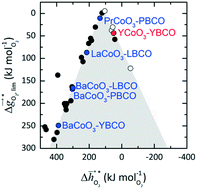High redox performance of Y0.5Ba0.5CoO3−δ for thermochemical oxygen production and separation†
Abstract
The efficient production and separation of oxygen is essential for numerous energy-intensive industrial applications in the fuel and mineral processing sectors. A thermochemical redox cycle is considered for separating oxygen from atmospheric air and other gas mixtures using solar or waste process heat. Based on electronic structure (DFT) computations Y0.5Ba0.5CoO3−δ is selected as a redox material, which surpasses the redox performance of state-of-the-art Cu2O. The thermochemical oxygen production is experimentally demonstrated by applying a temperature/pressure swing between 573 K at 0.2 bar O2 and 873 K at 1 bar O2. An energy balance shows the feasibility of using process waste heat from the solar thermochemical CO2/H2O splitting cycle and the potential to compete vis-a-vis with cryogenic distillation. Exploratory runs with a packed-bed reactor indicate the potential of both thermochemical oxygen production and separation for scale-up and industrial implementation.



 Please wait while we load your content...
Please wait while we load your content...